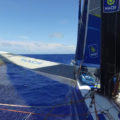Solo Round the World, MACIF soon to take off again
EnglishIn evidenzaOceanoRecordVela 23 Novembre 2017 Zerogradinord 0
Indian Ocean – After a little over 17 days at sea, François Gabart is still in the lead by about 1 and a half days in relation to the Thomas Coville’s time, the current holder of the single-handed round the world record. The MACIF skipper hopes to pick up speed again this Tuesday evening, after being forced to sail south to reposition himself in front of a low-pressure area, which slowed him down slightly and meant that he has had to watch out for ice floes. He should round Cape Leeuwin between Thursday and Friday.
Although, after entering the Indian Ocean last Thursday, he had initially planned to position himself behind a low-pressure area and let himself be sucked along by it as far as Australia, François Gabart had to review his strategy at the end of the weekend, as the low-pressure area had not developed in the way he had hoped: “It was not moving out of the way properly. It was spreading and blocking our passage. So, we chose to reposition ourselves in the south to recover the wind again which is beginning to lift,” said the skipper on Tuesday during a radio session organized at Macif’s headquarters in Niort, which many of the group’s employees attended. Even though, the MACIF trimaran’s trajectory has been fairly straight up until now, she had to sail south to position herself ahead of a new low-pressure system from the West, which will drive her towards Cape Leeuwin, to the south-west of Australia, in the coming days. She should round the Cape on Thursday evening or Friday morning, and still maintain a lead in relation to Sodebo. On Monday, she sailed down to a latitude of 54°50, less than 800 miles from Antarctica, where, just one year earlier, Thomas Coville sailed a course on the same longitude, 43° south! “For some time now, it has been quite unusual to take this route in round the worlds, because, as a rule, the ice gates force us to follow more northerly courses”, said François Gabart.
Still located in a very southerly position (53°50) on Tuesday, the MACIF trimaran will sail south of the Kerguelen Islands, before heading a little further up in search of the wind he’s expecting to meet and which was part of his initial strategy. “Icebergs have been detected quite close by, north east of Heard Island (a very small island located 50° south). As a precaution, I am sailing round by the north and the idea is to set a 70-80 course (East North East) in the 24 to 36 hours to come, which will bring us back towards the latitude of the Kerguelen Islands, 48-50° North,” he explains. “We’re going to try and go around to give ourselves a little margin. I hope that I’m not going to stay too long in this area, because it’s a little tricky. It’s nice to come here, but it’s also nice to leave!”.
The MACIF trimaran will get moving again, as of Tuesday afternoon, thanks to a new position further north in the Indian Ocean, and will be driven by the low-pressure system behind him. This will mean faster speeds. “If everything goes well, I will have two or three fairly difficult days ahead that will be potentially very fast,” says François Gabart. I will have to try and be smart and go fast in the right places to avoid the worst of the swell and the wind, if this low-pressure system should get stronger. The faster I go, the further ahead of the strong winds I will be.” For these weather conditions, the skipper has taken out his rugby-style costume, together with helmet and protection: “At the moment, I’m constantly wearing knee pads and thigh protection pads, and whenever things get moving, I put on my rugby-style helmet and wear protection on the sides of my chest and on my elbows. The danger when things are moving fast, is when you hit something or when you are thrown around the boat. In this case, prevention is better than cure.”
| Vela20513 | In evidenza5780 | |
| Monotipia4083 | Oceano2682 | |
| Altura2394 | Breaking news2238 | |
| Derive1982 | English1641 | |
| America's Cup1528 | Classi Olimpiche1324 |



No comments so far.
Be first to leave comment below.